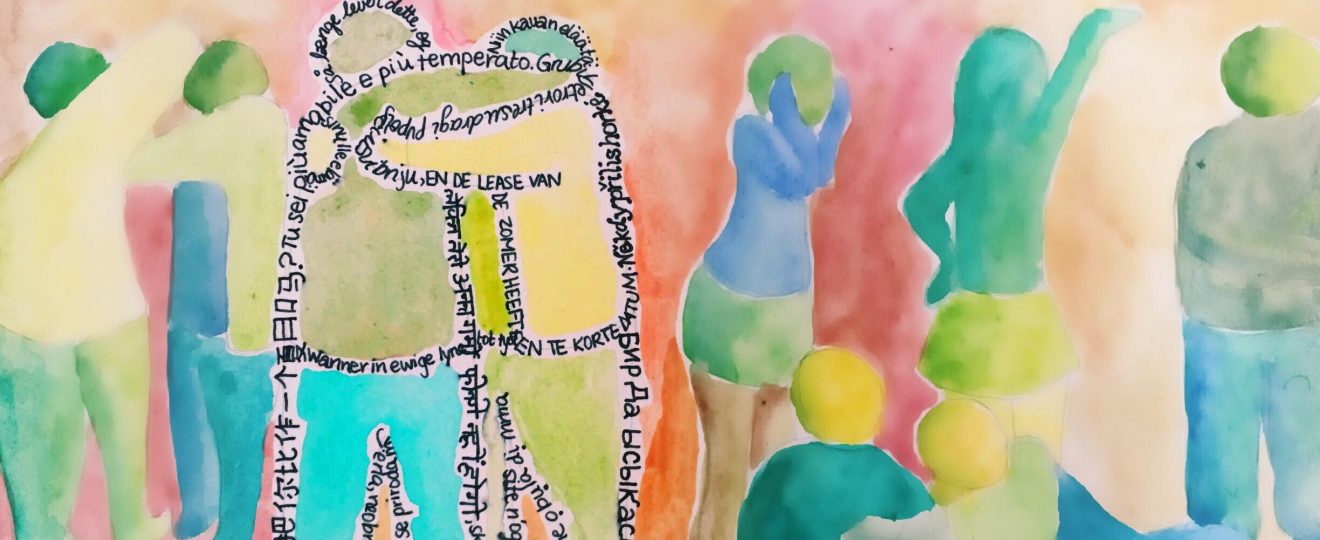“The limits of my language mean the limits of my world”
-Ludwig Wittgenstein in his book the Logico-Tractatus Philosophicus.
Language is widely and obviously acknowledged as, quite simply, important.
To use an individual’s name in a sentence makes them feel good, knowing how to say “hello, my name is __” in multiple languages is an impressive party trick, saying “I feel that you were rude” instead of “you were rude” can squash potential conflict and harbour peaceful communication, and saying “fuck you” can incite a riot.
Language can be the rose quartz vessel with which we communicate our adoration. It can be the navy blue paints we stir to effectively illustrate a clear picture of our tumultuous internal angst. Language can be the heavy stones that build immovable walls between geographically diverse individuals, just as well as it can be the cement to bridge them toward similarity.
But, further than that, what is the significance of language? What are the parameters of language’s power beyond emotional influence and conversational clarity?
One of the most open-ended and hotly contested questions for and between linguists, sociologists, historians, scientists, and anthropologists alike is: Does language construct our individual reality?
That is, do speakers of different languages genuinely think differently from one another? Or are our words merely the product of our grammatical structures, influencing only the way we say things, and not the way we see them?
According to Benjamin Lee Whorf, language can not only alter cultural custom, but it can be a driving force distinguishing various people’s perception of the world around them. After his study comparing *Standard Average European languages to the language of the Hopi people and drawing heavily from his mentor Edward Sapir, Whorf developed his principle of Linguistic Relativity: the belief that language can influence culture, psychology, or general viewpoints. His work was nothing short of revolutionary.
In studying Standard Average European, Whorf found that plurals work in a fashion more abstract than generally recognized or acknowledged by the speakers of the languages, primarily due to the existence of what is called “imaginary plurals”. For instance, using plurals such as “ten men” references a group of objects that can be objectively perceived and experienced at once. However, in Standard Average European one can also say “ten days” and refer to the plurality of the days, which can not be experienced objectively at once. The “days” are an abstract projection of a future occurrence, and therefore imaginary. Put simply, we can see ten men in front of our very eyes, whereas there is no physical and immediate manifestation of ten days we can experience. Yet the way in which we structure these plurals does not fluctuate depending on these differences. They don’t fluctuate at all.
From this, Whorf dove deeply into the way in which the cyclicity of time relates explicitly to these plurals. In Standard Average European, there are innate references to time and subsequent
instinctive importance placed upon the imagined confines of time. This goes to the extent to which time has become “objectified”. As Whorf puts it, concepts of time lose contact with the subjective experience of “becoming later” and are “objectified in quantities”.
But why does this matter? How do these plurals and specifically those relating to temporal units affect a Standard Average European view of the world, as opposed to any other cultures view?
The Standard Average European construction of time-related-terminology permeates many aspects of Western culture. For example, the focus on keeping records, bookkeeping, accounting, and diaries. It is a direct manifestation of the objectification of time because (again, as said by Whorf) “we set down our estimates of the future in the same shape as our records of the past, producing programs, schedules, budgets”. This further transforms the Western culture into one interested in and governed by exact sequences, calendars, clocks, and histories.
If you yourself are from a culturally Western country, consider how often you refer to time, deadlines, or even measure out your existence temporally as opposed to sensorily or cardinally.
To us, time and exact sequences seem as inevitable and as prevalent as gravity. This, however, is not universally the case.
When comparing this to the Hopi culture, where the system of language is radically different, as observers we begin to reap the cultural differences that are born of varying linguistic structures, and as such, understand how reality itself can be constructed diversely. In Hopi, imaginary plurals are not used. To say “ten days” one would have to instead say “the tenth day”. The Hopi people do not objectify time constraints and give them the weight of nominal consideration. Instead, they measure and label reality primarily in terms of events, those of which differ between the “objective” (referring to perceivable physical experiences) and “subjective” (referring to the expression of non-visible or intangible “intensity factors”). This means that time, for instance, does not become later and later in a unified way. Since the Hopi do not see time from the same cyclical viewpoint as speakers of Standard Average European, they work within a present situation that does not and will not repeat the same way as it would for those in the Western culture. 9 o’clock doesn’t come around every day. 9 o’clock is newer with each passing day, and cannot be compared to the once lived shadow of itself.
By using a language system which excludes imaginary plurals, the perception of time shifts from being cyclical, repetitive, and inherently nominal, into a version of time that contains a much larger focus on the present moment, as imagining something happening in 10 days is not customary within the Hopi language. In Whorf’s words,
“instead of our linguistically promoted objectification of that datum of consciousness we call ‘time’, the Hopi language has not laid down any pattern that would cloak the subjective “becoming later” that is the essence of time”.
Language can construct our realities in seemingly smaller ways as well. As cognitive scientist and professor, Lera Boroditsky brings up in her UCTVSeminar talk, language shifts reality in the domain of space and navigation as well as in time. Boroditsky mentions that while some languages may use terms such as left and right to navigate, others use cardinal directions, such as “north”, “east”, “south”, or “west”. In fact, using these terms has even lead to certain language speakers being able to stay physically oriented on a cardinal scale, in a way previously considered biologically impossible for human beings to do. These speakers live in a world in which direction is separate from their body. There is only one “North”. For those who use ‘left’ and ‘right’, direction is locked onto their individual body. You can clarify the direction ‘left’ as being your left or theirs, for instance.
In terms of the classificatory, grammatical gender can shift language speakers’ perceptions of the world. If we place the tenants of gender upon one item, we fluidly change the way in which we classify or describe it. For instance, in one of Boroditsky’s more infamous examples, a German speaker uses a feminine pronoun when discussing a bridge, whereas a Spanish speaker uses a masculine one. When German speakers were asked to describe a bridge, they used adjectives closely related to stereotypical descriptions of femininity. “Elegant”, “beautiful”, and “graceful” were among the terms used. However, when Spanish speakers were asked to describe a bridge, the words were more masculine-centric, such as “strong”, “long”, or “stable”. This distinction calls in its own host of gender-related socially constructed systems, but in particular, highlights how, while to you or me, a bridge is a bridge is a bridge, it’s very characteristics can transform in the eyes of different language speakers, even if it’s appearance has remained stagnant.
When we consider the weight we each put upon concepts such as time, direction, gender, and categorisation (particularly the importance we place upon our own individual versions of said concepts) we begin to understand just how crucial our own perceptions are in crafting our form of reality. When the obvious (to us) is made strange (by acknowledging other viewpoints), it is then we can see how truly subjective much of our existence is.
So why don’t we want to accept that indeed language can shape individual realities? Perhaps it is because we don’t want to classify reality as something so malleable, as something moveable and subjective to experience and culturally constructed systems. It makes us feel safe and stable to assume that existence is objective. The things we value are valued precisely because we assume them to be as inevitable as the sun setting, or as a spider spinning it’s web. In truth, these natural social processes are not natural at all. They are decided and repeated. Habits we learn as children. Habits crafted aeons ago for convenience’s sake. Habits that have danced through historical lineage only to grab our eager hands and continue the movement. If there are indeed around 7000 languages on this earth, then there exists 7000 linguistic universes, all within our ability to comprehend. 7000 different habits, dancing generation to generation.
It may do us well to wonder,
What would the world look like to us, had we not been taught to speak a certain way within it?
*Standard Average European (SAE) is a concept introduced by Benjamin Whorf to unify the modern Indo-European languages of Europe by their shared similarities, such as syntax, grammar, and vocabulary and its use. This also includes the relationships between words and their origins, word order, and more, categorising them as being separate from other languages and dialects which do not share these similarities.
“Each language is a unique repository of facts and knowledge about the world that we can ill afford to lose, or, at the least, facts and knowledge about some history and people that have their place in the understanding of mankind. Every language is a treasury of human experience. Eyak doesn’t give a damn about tenses. But it sure does give a damn about other things, much more than I do. Therefore it broadens your thinking, enriches your ability to understand the world-to deal with reality and experience.”
-Michael Krauss on the Eyak language of Alaska.
art by Desiree Finlayson




